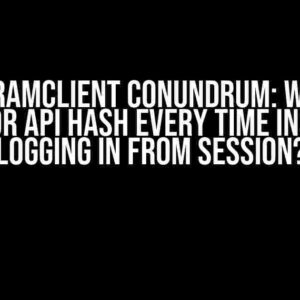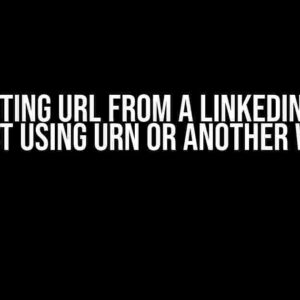Have you ever experienced the frustration of receiving a 403 Forbidden error when trying to access private endpoints through an API, despite being authenticated? You’re not alone! This perplexing issue has left many developers scratching their heads, wondering why their API can’t access the very endpoints they’re supposed to. Fear not, dear reader, for today we’ll embark on a journey to demystify this enigmatic problem and provide you with actionable solutions to overcome it.
What’s Behind the 403 Forbidden Error?
The 403 Forbidden error is an HTTP status code that indicates the server understands the request, but refuses to authorize it. In the context of APIs, this error usually occurs when the API doesn’t have the necessary permissions or credentials to access private endpoints. But, what if you’re certain that your API is authenticated and should have access? That’s where things get interesting…
Culprits Behind the 403 Forbidden Error
- Authentication vs. Authorization: Are you confusing authentication with authorization? Make sure you understand the difference between verifying who you are (authentication) and what you’re allowed to do (authorization).
- Insufficient Permissions: Double-check that your API has the necessary permissions to access the private endpoints. Are you using the correct roles or scopes?
- Token Validation: Is your API token valid, and is it being sent correctly with each request?
- Rate Limiting: Are you hitting rate limits that prevent your API from accessing private endpoints?
- CORS Issues: Are cross-origin resource sharing (CORS) policies blocking your API’s requests?
- Network or Server Issues: Is the server or network experiencing issues that prevent your API from accessing private endpoints?
Step-by-Step Troubleshooting Guide
Now that we’ve identified the potential culprits, let’s walk through a step-by-step troubleshooting process to resolve the 403 Forbidden error:
Step 1: Verify Authentication
// Check if your API is authenticated
fetch('/api/private-endpoint', {
headers: {
Authorization: 'Bearer YOUR_API_TOKEN'
}
})
.then(response => response.json())
.catch(error => console.error('Error:', error))
If you’re using a library or framework, ensure you’re correctly setting the API token or credentials.
Step 2: Check Permissions and Scopes
Verify that your API has the necessary permissions and scopes to access private endpoints:
- Review your API’s roles and scopes in the authentication system or documentation.
- Check if the private endpoint requires specific permissions or scopes.
- Ensure your API is using the correct permissions or scopes when making requests.
Step 3: Validate the API Token
Verify that your API token is valid and correctly formatted:
// Check the API token's validity
fetch('/api/token-validation', {
headers: {
Authorization: 'Bearer YOUR_API_TOKEN'
}
})
.then(response => response.json())
.catch(error => console.error('Error:', error))
If the token is invalid, refresh or obtain a new token.
Step 4: Check Rate Limiting
Verify if you’re hitting rate limits:
- Review your API’s rate limit documentation or usage guidelines.
- Check the response headers for rate limit information (e.g., X-RateLimit-Limit, X-RateLimit-Remaining).
- Implement rate limiting strategies, such as caching or exponential backoff, to avoid hitting limits.
Step 5: Investigate CORS Issues
Check if CORS policies are blocking your API’s requests:
- Review your API’s CORS configuration or documentation.
- Check the response headers for CORS-related information (e.g., Access-Control-Allow-Origin, Access-Control-Allow-Headers).
- Configure CORS policies to allow your API’s requests.
Step 6: Check for Network or Server Issues
Verify if there are any network or server issues blocking your API’s requests:
- Check the server’s status page or documentation for any known issues.
- Use tools like `curl` or `postman` to test the private endpoint directly.
- Contact the server’s administrators or support team if you suspect an issue on their end.
Additional Tips and Best Practices
To avoid the 403 Forbidden error and ensure seamless API interactions, follow these additional tips and best practices:
Use Token Blacklisting
Implement token blacklisting to revoke access to compromised or expired tokens:
// Token blacklisting example
if (token.isRevoked || token.isExpired) {
// Revoke the token and obtain a new one
revokeToken(token);
token = obtainNewToken();
}
Implement API Key Rotation
Rotate your API keys regularly to minimize the risk of key exposure:
// API key rotation example
const apiKey = rotateApiKey();
// Use the new API key for subsequent requests
fetch('/api/private-endpoint', {
headers: {
Authorization: `Bearer ${apiKey}`
}
})
Monitor API Performance and Errors
Monitor your API’s performance and errors to quickly identify and troubleshoot issues:
// API performance monitoring example
const apiMonitor = require('api-monitor');
apiMonitor.on('error', (error) => {
console.error('API Error:', error);
});
apiMonitor.on('slowResponse', (response) => {
console.warn('Slow Response:', response);
});
Conclusion
The 403 Forbidden error can be a frustrating and perplexing issue when working with APIs. However, by understanding the underlying causes and following the step-by-step troubleshooting guide, you’ll be well-equipped to resolve the error and ensure your API can access private endpoints without issues. Remember to implement best practices like token blacklisting, API key rotation, and performance monitoring to minimize the risk of encountering the 403 Forbidden error in the future.
Key Takeaways
- Verify authentication and authorization
- Check permissions and scopes
- Validate the API token
- Check rate limiting
- Investigate CORS issues
- Check for network or server issues
- Implement token blacklisting and API key rotation
- Monitor API performance and errors
With these key takeaways and the comprehensive guide provided, you’ll be able to troubleshoot and resolve the 403 Forbidden error, ensuring your API can access private endpoints with confidence. Happy coding!
| Error Code | Description |
|---|---|
| 403 Forbidden | The server understands the request, but refuses to authorize it. |
This article has provided a comprehensive guide to resolving the 403 Forbidden error when accessing private endpoints through an API. By following the step-by-step troubleshooting process and implementing best practices, you’ll be able to overcome this error and ensure seamless API interactions.
Frequently Asked Question
Having trouble accessing private endpoints with your API? Don’t worry, we’ve got you covered!
Why am I getting a 403 Forbidden error even though I’m authenticated?
This error can occur if the user doesn’t have the necessary permissions or roles to access the private endpoint. Double-check the user’s permissions and make sure they align with the required access level for the endpoint.
Are there any specific headers I need to include in my API request?
Yes, you’ll need to include an Authorization header with a valid token or credentials. This token should be obtained through an authentication flow, such as OAuth or username/password authentication. Ensure the token is valid and properly formatted.
Is it possible that the API endpoint itself is not configured correctly?
Absolutely! It’s possible that the private endpoint is not correctly configured to allow access. Verify that the endpoint is properly set up to accept authenticated requests and that any necessary permissions or access controls are in place.
Could caching be causing the 403 Forbidden error?
Yes, caching can sometimes cause issues. Try clearing any cached responses or adding Cache-Control headers to your request to ensure you’re getting a fresh response from the server.
Are there any tools or logs I can use to troubleshoot the issue?
Yes! You can use tools like Postman or cURL to inspect the request and response headers. Additionally, check the API’s server logs for any error messages or clues about what’s causing the 403 error. This will help you identify the root cause of the issue.





